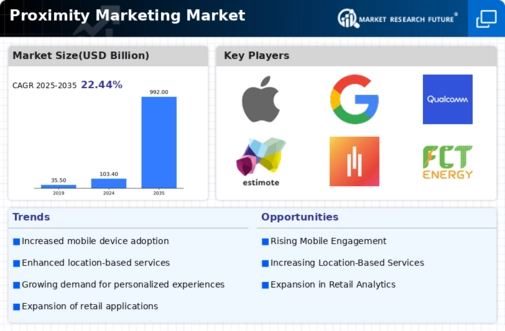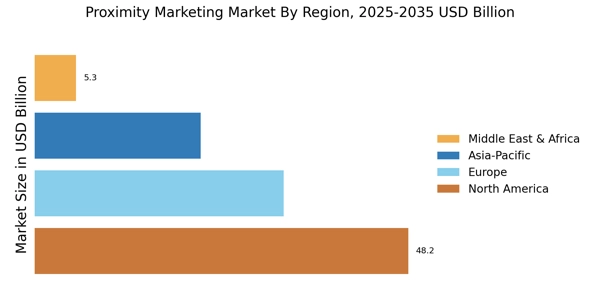Rising Smartphone Penetration
The increasing penetration of smartphones is a pivotal driver for the Proximity Marketing Market. As of 2025, it is estimated that over 80% of the population in developed regions owns a smartphone, facilitating the adoption of proximity marketing strategies. This trend enables businesses to engage consumers through location-based services, enhancing customer experiences. The proliferation of mobile applications that utilize proximity marketing technologies, such as Bluetooth and NFC, further supports this growth. With consumers increasingly relying on their smartphones for shopping and information, businesses are likely to leverage these devices to deliver personalized content and promotions. Consequently, the Proximity Marketing Market is poised for substantial growth as companies seek to capitalize on the smartphone trend to reach their target audiences effectively.
Increased Focus on Customer Engagement
The emphasis on customer engagement is becoming increasingly vital for businesses, driving growth in the Proximity Marketing Market. Companies are recognizing that engaging customers in meaningful ways can lead to higher retention rates and increased sales. As of 2025, research suggests that businesses that prioritize customer engagement see a 20% increase in revenue. Proximity marketing offers unique opportunities to connect with consumers at critical moments, such as when they are near a store or event. By delivering timely and relevant messages, businesses can enhance the customer experience and foster brand loyalty. This focus on engagement is likely to propel the Proximity Marketing Market forward as companies seek innovative ways to interact with their audiences.
Growing Demand for Personalized Marketing
The demand for personalized marketing experiences is a crucial driver for the Proximity Marketing Market. Consumers are increasingly expecting tailored content and offers that resonate with their preferences and behaviors. As of 2025, studies indicate that over 70% of consumers are more likely to engage with brands that provide personalized experiences. Proximity marketing allows businesses to deliver customized messages based on a consumer's location and past interactions, thereby enhancing engagement and conversion rates. This trend is particularly evident in retail, where brands utilize proximity marketing to send targeted promotions to customers as they enter stores. Consequently, the Proximity Marketing Market is likely to thrive as businesses recognize the value of personalization in driving customer loyalty and sales.
Expansion of Retail and E-commerce Sectors
The expansion of retail and e-commerce sectors is a significant driver for the Proximity Marketing Market. As of 2025, the retail sector is projected to grow substantially, with e-commerce sales expected to account for a significant portion of total retail sales. This growth creates opportunities for businesses to implement proximity marketing strategies that enhance the shopping experience. Retailers are increasingly utilizing proximity marketing to attract customers to physical stores while also integrating online and offline experiences. The ability to send location-based promotions and notifications can drive foot traffic and boost sales. Therefore, the Proximity Marketing Market is likely to benefit from the ongoing expansion of these sectors as businesses seek to leverage proximity marketing to optimize their operations.
Advancements in Location-Based Technologies
Technological advancements in location-based services are significantly influencing the Proximity Marketing Market. Innovations such as GPS, Bluetooth Low Energy (BLE), and Wi-Fi positioning systems have improved the accuracy and efficiency of proximity marketing campaigns. As of 2025, the market for location-based services is projected to reach several billion dollars, indicating a robust demand for these technologies. Businesses are increasingly adopting these solutions to enhance customer engagement and drive sales through targeted marketing efforts. The ability to deliver real-time offers and information based on a consumer's location is becoming a competitive advantage. Therefore, the Proximity Marketing Market is likely to expand as companies invest in these advanced technologies to optimize their marketing strategies.


















Leave a Comment